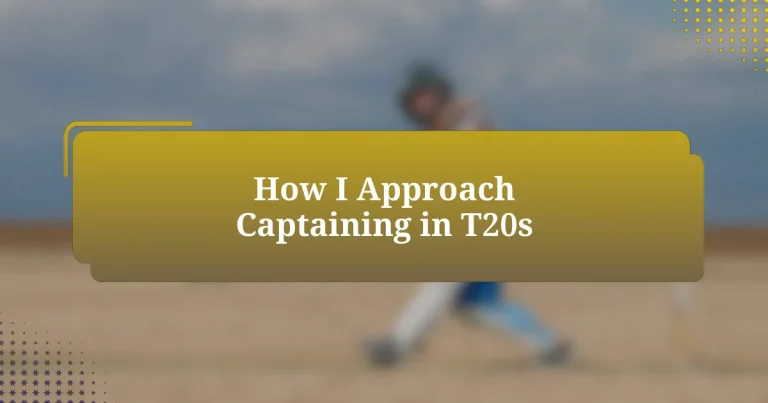Key takeaways:
- Each cricket format, such as Test and T20, has distinct strategies and rhythms that influence gameplay and captaincy decisions.
- T20 cricket emphasizes aggressive batting and quick decision-making, making captains’ roles crucial under pressure.
- Effective captaincy involves thorough preparation, team cohesion, and adaptability to changing game dynamics.
- Personal experiences, open communication, and fostering trust within the team significantly enhance a captain’s effectiveness and team performance.
Author: Evelyn Hartwell
Bio: Evelyn Hartwell is a contemporary fiction author known for her poignant storytelling and richly drawn characters. With a background in psychology, she explores the intricacies of human emotions and relationships in her novels. Her work has been featured in several literary magazines and anthologies, earning accolades for its depth and insight. When she’s not writing, Evelyn enjoys hiking in the mountains and nurturing her passion for photography. She lives in Asheville, North Carolina, with her two rescue dogs and a stack of well-loved books.
Understanding cricket formats
Cricket formats offer a fascinating glimpse into the sport’s versatility, showcasing everything from the classic Test matches to the fast-paced T20s. I still remember my first encounter with a T20 match; the energy was electric, unlike anything I had experienced in the longer formats. It made me wonder, why does this format resonate so strongly with both players and fans alike?
Each format carries its own unique rhythm and strategy. Test cricket is a marathon, requiring patience and skill over days, while T20 is a sprint that demands quick thinking and aggression. Have you ever noticed how a captain’s decisions fluctuate between these formats? Personally, I’ve felt the pressure that comes with leading a team in T20s, where every choice can change the game’s outcome instantly.
Furthermore, understanding these formats is essential for appreciating how teams and players adapt their styles. I find myself often analyzing how different captains strategize their gameplay depending on whether they’re in a T20, ODI, or Test match. Isn’t it intriguing to think about how a single player’s mindset can shift drastically with the format? These nuances in strategy make studying cricket formats not just interesting but also a journey of discovery for both players and fans.
Overview of T20 format
T20 cricket is a relatively new and explosive format, capturing the essence of what makes the game thrilling. With each match lasting only about three hours, it offers a blend of athleticism, strategy, and entertainment that keeps spectators on the edge of their seats. I still remember the anticipation before my first live T20 game; the crowd’s energy was palpable, and the atmosphere felt like a festival.
What truly sets T20 apart is the emphasis on aggressive batting and dynamic bowling. This format challenges players to think on their feet, making split-second decisions that could swing the match. I often think of that nail-biting final over during my last T20 match—one key decision, whether to go for a big hit or play it safe, left me with my heart racing. How exhilarating it is to witness such raw passion unfold in under two hours!
In T20, every ball matters, and this often leads to unforeseen and dramatic outcomes. Captains face immense pressure to innovate their tactics, and I’ve found myself experimenting with field placements and bowling changes as if I were conducting a live orchestra. This fast-paced nature not only keeps the players engaged but also draws in fans who crave excitement. Isn’t it fascinating how a game structured around a mere 120 legal deliveries can tell a riveting story?
Key roles of a captain
When I think about the key roles of a captain in T20 cricket, the first that comes to mind is decision-making under pressure. I’ve experienced instances where a quick decision on the batting order or a bowling change completely shifted the momentum of the game. It’s incredible how, in a matter of moments, the captain’s call can determine the outcome, making it a pivotal role that demands both intuition and strategic foresight.
Another significant aspect is ensuring team cohesion. In my previous T20 matches, I’ve felt a tremendous responsibility to foster an environment where every player feels valued and motivated. The captain is often the glue that binds the team together, encouraging open communication and trust. I’ve found that when everyone is on the same page, our collective performance improves, and it makes the celebrations even sweeter when we win as a unified unit.
Lastly, effective captains must possess the ability to read the game as it unfolds. I recall a match where I had to adjust our strategy mid-game because the opposition’s batsmen were getting comfortable. Recognizing that moment was crucial; it reminded me how essential adaptability is in T20 cricket. A captain’s success lies not just in planning but also in adapting to the unpredictable nature of the sport. What do you think, can a moment of brilliance change the course of a match? Absolutely, and it often starts with the captain’s instincts.
Strategies for effective captaincy
When I approach captaincy in T20s, I focus heavily on pre-match preparation. An incident that stands out to me is when I spent extra time analyzing the opposition’s recent performances and strategies. This preparation allowed me to set specific field placements and choose bowlers based on their weaknesses. It made me wonder, how much of our success stems from what we do before the first ball is bowled?
In the heat of the match, I find that reading the energy of my team is equally vital. I recall one game where our pace bowler looked off his game, struggling with rhythm. I made the quick decision to give him a break while bringing in a spinner to change the pace, which turned out to be a game-changer. Isn’t it fascinating how a small shift can bring a fresh wave of momentum to the team and capture the crowd’s excitement?
Another strategy I truly believe in is embracing failure as a learning tool. After we experienced a tough loss in a close game, I gathered the team for an open discussion about what went wrong. Sharing our feelings and learning from the experience helped strengthen our resolve. Have you ever noticed how a setback can unite and motivate a team to come back stronger? This is where the real power of effective captaincy lies—transforming challenges into stepping stones for growth.
Approaching match preparations
When I think about match preparations, I find that involving my players in the planning process makes a significant difference. In one memorable instance, I organized a team meeting before an important match where everyone could share their thoughts on how to approach the opposition. That collaborative atmosphere not only boosted confidence but also led to valuable insights I hadn’t considered. Isn’t it amazing how empowering others can elevate everyone’s game?
Preparing visualization techniques has also worked wonders for me. Before stepping onto the field, I often encourage the team to visualize our game plan—how we want to play certain scenarios and handle the pressure. I vividly remember a match where one of our younger players spoke about picturing his role in our strategy. It gave him a newfound focus, and his performance that day was simply outstanding. Don’t you think that mental preparation can be just as crucial as physical training?
Analyzing pitch conditions before a match is another critical step in my preparations. Having a clear understanding of how the surface may behave can influence our batting and bowling strategies dramatically. Once, in a game where the pitch looked dry, I insisted we go with spinners in the early overs, which turned out to be a masterstroke as it caught the batting side off guard. How often do we underestimate the micro details that can sway the outcome of a match?
Leading the team on field
Leading a team on the field requires a balance of intuition and strategy. I remember a tense match where our batsman was struggling, and I could sense the shift in energy. Trusting my instinct, I called for a quick huddle to provide him with positive reinforcement and tactical adjustments. It wasn’t just about the runs; it was about restoring his confidence and lifting the team spirit in that moment of pressure. Have you ever noticed how just a few words can completely change the atmosphere?
Moreover, I’ve learned that being visible and approachable as a captain matters greatly. I make it a point to stay close to my players during crucial phases of the game, whether in the field or at the crease. A pat on the back or a simple nod of understanding can go a long way. There was a match where I saw one of our bowlers feeling the weight of expectations; I engaged with him between overs, chatting about his plans and reminding him of his strengths. That personal connection not only steadied his nerves but also revved up his performance. Isn’t it fascinating how small gestures can create a ripple effect?
Communication is another vital aspect of my on-field leadership. I always aim to be clear and concise with my instructions, especially during fast-paced moments. In one instance, we were setting fields for a final over, and rather than shouting orders, I took a breath and shared my vision calmly. The team responded positively, and we executed the plan perfectly, clinching a win in the dying moments of the game. I find that when I communicate openly, it fosters trust among players. Isn’t it interesting how essentially everyone on the team plays a role in the leadership dynamic?
Personal experiences in captaincy
When I think about my journey in captaincy, a vivid memory stands out from a particularly challenging tournament. We had just lost our first two matches, and the weight of disappointment was palpable in the dressing room. I decided to call for a team meeting, but instead of focusing on the losses, I encouraged everyone to share their own thoughts and strategies. This open dialogue not only boosted morale but also revealed the collective wisdom within the team. Have you ever tried turning setbacks into opportunities by simply listening to others?
Another experience that shaped my captaincy was during a knockout match when we were chasing a daunting total. Tension filled the air, and I could feel that our young opener was feeling overwhelmed. I remember sitting with him at the crease, sharing stories about my own struggles and emphasizing the importance of focusing on each ball. That moment of vulnerability forged a solid bond and inspired him to play freely, which ultimately led us to victory. Isn’t it amazing how sharing personal experiences can create trust?
Lastly, I’ve come to realize that my leadership extends beyond just tactics and strategies; it’s deeply personal. There was a game where our last bowler had to defend a narrow margin, and I could sense his anxiety. Instead of playing the generic captain’s role, I walked up to him and said, “You’ve got this; remember, cricket is a game of chance.” That simple reassurance transformed his mindset, and he bowled a brilliant final over to seal our win. How often do we underestimate the power of belief in someone’s ability?



